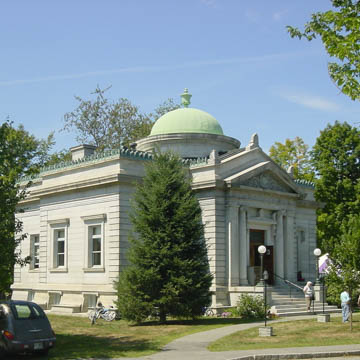The ideal design of the rural public library building had become well established when John Graves Shedd and his wife Mary donated the Shedd-Porter Memorial Library in memory of their parents. The library might be regarded as a paradigm of the small library of the early twentieth century, being classically inspired, symmetrical in plan, provided with two comfortable reading rooms flanking a rotunda and circulating desk, and built from the most imperishable of materials. The building was designed by one of the most experienced and prolific firms of library designers in the early twentieth century: the architectural partnership of William H. McLean and Albert Hayden Wright of Boston, active under the firm name of McLean and Wright from about 1902 to 1911. In New Hampshire, the partnership was responsible for more public library buildings than any other single firm or architect—eight in all. Two were built with funding supplied by Andrew Carnegie; the remainder by philanthropists with local connections, like the Shedds. Although typical in plan, the Shedd-Porter Library is exceptional in its materials and detailing, being built of richly carved Maine granite and provided with a granite cupola to gather natural light that suffused the interior through a stained glass window in the domed ceiling of the rotunda. The curved plaster walls below the base of the dome create a transition from the circle above to a square entablature below. The corners of this entablature are supported by clusters of Greek Ionic columns and pilasters that enclose steel supports for the granite drum that rises from the roof of the building. The column shafts, and those of the pilasters they embrace, are executed in scagliola, colored and veined to resemble Siena marble. Both the columns and the pilasters bear elaborated capitals, those of the columns bearing a close resemblance to the granite Ionic capitals that frame the front entrance, symbolic of wisdom. The center of the rotunda of the library is marked by a Siena marble circle in the floor, surrounded by white mosaic tiles interrupted at intervals by concentric mosaic borders. Electric light fixtures throughout the library take advantage of the fact that the village had had access to electricity since 1897. The appearance of the library has changed little since it was dedicated by donor Shedd, the second president of the well-known Marshall Field department store in Chicago. In 1926, William H. McLean, surviving partner in the partnership that had designed the building, was consulted about leakage in the original flat roof, and designed a new, pitched roof system that covered the original but obscured the lower portion of the granite cupola.
You are here
Shedd-Porter Memorial Library
1910, William H. McLean and Albert Hayden Wright. 3 Main St.
Coordinator:
Bryant F. Tolles Jr. and James L. Garvin
If SAH Archipedia has been useful to you, please consider supporting it.
SAH Archipedia tells the story of the United States through its buildings, landscapes, and cities. This freely available resource empowers the public with authoritative knowledge that deepens their understanding and appreciation of the built environment. But the Society of Architectural Historians, which created SAH Archipedia with University of Virginia Press, needs your support to maintain the high-caliber research, writing, photography, cartography, editing, design, and programming that make SAH Archipedia a trusted online resource available to all who value the history of place, heritage tourism, and learning.














